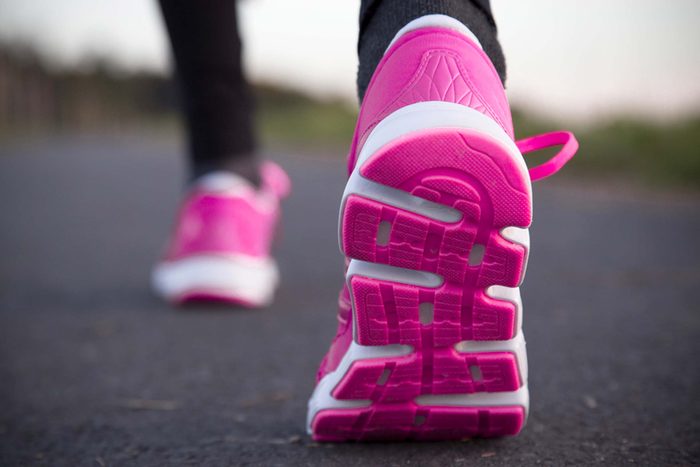
Setting unrealistic goals
It’s exciting to start a running routine, but you don’t want to set your sights too high. “Be smart and set the right goals,” says Meghan Kennihan, a certified personal trainer and running coach. Sign up for a fun run or a 5K first, before even thinking about a marathon. “Your goal should simply be to finish,” Kennihan says. “If you push yourself too much, you are dramatically increasing the likelihood of injury and not even seeing the starting line.”

Stretching the wrong way
Most runners believe they need to “stretch out” before their runs, so they put their legs up on a ledge to stretch their hamstrings, or they stretch their calves on a curb. “Static stretching is a bad idea before running, because it actually hinders your running performance and can lead to injury,” says Kennihan. “It can actually cause a decrease in muscle function.” Instead of telling your body to relax before it performs, switch to dynamic stretching, which trains the muscles to warm-up and fire the way you want them to through a series of dynamic movements. Leave the static stretching for after your run.

Not eating before a run
It’s important to fuel your body with the right nutrients before going on a major run, but the timing matters as well. “A lot of runners carb-load for a 7 a.m. race at 6 p.m. the day prior, giving the glycogen stores just enough time to actually burn off rather than be useful as fuel for the race,” says Amanda Dale, trainer and sports nutritionist. “Either plan a later dinner the night before a big race, or set your alarm for 2 to 4 hours before your actual wake up call, force down some complex carbs, and resume sleeping to make sure the fuel is fresh in your body.”

Going too fast
If you’re starting off your runs with a mad sprint, you’re going to get fatigued before your workout even kicks in. “Start slow, aiming to ‘negative split’ (run the last half of your run faster than the first) when you’re just starting out,” says Dale. In addition to helping you avoid early fatigue, slowing down your pace can also have positive long-term effects on your health. Research published in the Journal of the American College of Cardiology found that light joggers and moderate joggers had a lower mortality rate than joggers who ran faster than 7 mph.

Swinging your arms across your body
If you only think of proper form as it relates to the lower half of your body when running, that’s a mistake.”Think of your arms as oars next to your boat: They can either help push you along if they’re aligned, or completely slow you down if they’re out of sync,” says Dale. “Keep your hands and arms relaxed and swinging in a forward-back motion next to the body, ‘chopping’ through the air, rather than moving horizontally across the torso.”

Not hydrating enough
“Many runners suffer from dehydration because they underestimate how much water their body needs during training,” says Kennihan. You can test if you’re drinking enough water by weighing yourself before and after a run and trying to get your body weight back to what it was before the run by drinking enough water. You can also check the colour of your urine; it should be light yellow to clear. “Be wary though, there is such a thing as overhydrating,” says Kennihan. “So drink when you are thirsty and listen to your body.”

Taking overly long strides
You might feel like Superman flying across the tracks, but if your strides are too long, it can actually hurt your performance. “Endurance running in particular relies on short, low, efficient strides, with no wasted muscular effort or vertical motion,” says Dale. “The ideal steps-per-minute pace is 160 to 170, so it’s worth taking a few minutes to actually count and compare your strides, and then work on speeding them up with shorter steps.” Plus, make sure to avoid these treadmill mistakes.

Landing like a rock
When it comes to preventing injury, it’s important to pay attention to how you’re landing on your foot. A study from the British Journal of Sports Medicine found that the lighter your impact load, the lower your risk of injury. To prevent hard landings, the study suggests landing closer to the midfoot, which tends to be lighter than landing on the heel, and increasing the number of steps you take per minute.

Running through pain
Many runners think it’s normal to feel soreness in their shins, IT bands, or knees when they begin, so they choose to ignore it and keep running. “The best thing to do when in doubt about whether you should ‘run through’ the pain is don’t,” says Kennihan. “Ignoring aches and pains is the best way to get injured.” If you do feel pain or discomfort, take some rest days, and tend to your injury by following RICE (Rest, Ice, Compression, Elevation). Once you return to running, gradually build up your progress. (Learn more about common leg pain causes and how to treat them.)

Wearing the wrong shoes
Wearing the wrong sneakers can ruin your workout routine. “If you have a history of running injuries, there is no easy answer without a trained professional (not the guy at the mass market shoe store) watching the way you run and making a recommendation,” says Kathleen Lisson, CMT. “Ideally, a mold can be made of your foot and a custom orthotic can be made.”

Not taking your run out of the city
“If you live in a busy city, running along city streets is the easiest way to get in the miles, but if it’s possible, find a less polluted space for your long runs,” says Lisson. “Experiment with how you feel after an hour running from stoplight to stoplight and an hour running on a trail or by the ocean.” A review of literature published in the Journal of Sports Medicine found that running in polluted air doesn’t give you the same cognitive benefits as running in clean air. Exposure to air pollution can have negative effects on brain health as well as the lungs, so making the driver to a cleaner location might be worth the extra time.
Next, read up on what women need to know about running.
